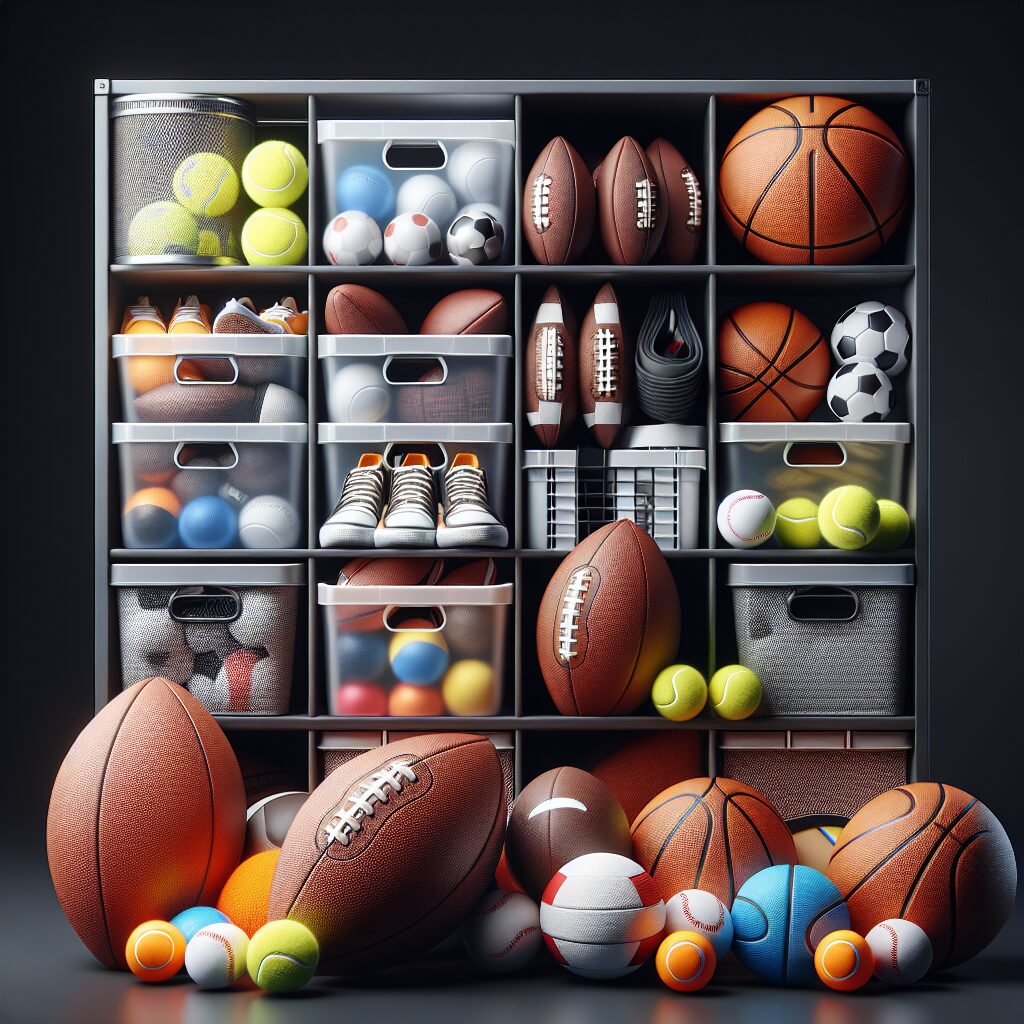Player Age and Ball Size: Age-Appropriate Choices
When it comes to sports, especially team sports like soccer or basketball, one crucial factor that is often overlooked is the player’s age and the appropriate ball size. The relationship between player age and the size of the ball used during gameplay is more important than you might initially think. In fact, this simple aspect can have a significant impact on player development, performance, and overall enjoyment of the game.
As children grow and develop, their physical abilities and coordination skills vary at different age ranges. Understanding this, sports organizations and coaches have established age-appropriate ball sizes to ensure that young players can fully participate and engage in the sport. For instance, using an oversized ball for a young child may hinder their ability to master skills such as dribbling, passing, or shooting accurately. On the other hand, using a smaller ball with older, more experienced players might limit their potential to showcase their skills or play at their optimum level. These age-appropriate choices in ball size are essential for creating a balanced playing field and fostering each player’s growth and confidence.
Moving forward, let’s delve into the key takeaways regarding the impact of player age on ball size. By understanding the significance of age-appropriate ball choices, coaches, parents, and players themselves can make informed decisions that enhance their overall sporting experience. Throughout the following sections, we will explore the benefits of using proper ball sizes for different age groups, discuss the potential challenges of mismatched ball sizes, and provide practical tips for selecting the right ball based on player age. So, let’s dive in and uncover the fascinating connection between player age and ball size in sports.
Key Takeaways
1. Player age plays a crucial role in determining the appropriate ball size for various sports, as it directly impacts the safety, effectiveness, and skill development of young athletes.
2. For children aged 4-12 years participating in soccer, basketball, and volleyball, age-appropriate ball sizes are fundamental in promoting better control, technique, and overall enjoyment of the game.
3. Size 3 balls are recommended for soccer players aged 4-8 years, while size 4 balls are suitable for those aged 9-12 years, ensuring optimal handling, passing, and shooting skills.
4. In basketball, players aged 5-8 years should utilize smaller size 3 or 4 balls, while players aged 9-12 years can transition to a size 5 ball for improved dribbling, shooting, and coordination.
5. Volleyball players aged 6-8 years should use a lighter and smaller size ball to enhance their precision, serving, setting, and overall technique, gradually progressing to a larger and heavier size as they advance in age and skill level.
Player Age and Ball Size: What are the Age-Appropriate Choices for Young Athletes?
Why is Choosing the Right Ball Size Important for Young Athletes?
Choosing the appropriate ball size for young athletes is crucial as it directly impacts their skill development and overall game experience. By selecting the right ball size, players can enhance their coordination, accuracy, and technique, while also reducing the risk of injury. Ensuring an age-appropriate ball size allows young athletes to better manipulate the ball, improving their control and confidence on the field.
Factors to Consider when Determining the Ball Size for Young Players
Several key factors should be taken into account when determining the appropriate ball size for young players. These factors include the player’s age, physical development, skill level, and the specific sport they are participating in. Each sport typically has guidelines regarding the recommended ball size for different age groups. Understanding these factors will help coaches, parents, and players make informed decisions when it comes to selecting the right ball size.
Recommended Ball Sizes based on Player Age
Age Group 3-5
For children aged 3 to 5, it is advisable to use size 3 balls. These smaller balls are lightweight and easier to handle, promoting better control and enhancing motor skills development in the early stages.
Age Group 5-8
Young athletes between the ages of 5 and 8 are best suited for size 4 balls. These slightly larger balls allow for increased ball control as players continue to refine their skills, providing a smooth transition towards playing with regulation-sized balls.
Age Group 8-12
Players aged 8 to 12 should use size 4 or size 5 balls, depending on their physical development and skill level. Size 4 balls are a suitable intermediate choice, while size 5 balls mirror the standard size used in most adult games.
Age Group 12+
For players aged 12 and above, utilizing standard size 5 balls is recommended. These balls are used in professional and competitive settings, providing young athletes with the opportunity to adapt and excel in real-game situations while preparing them for future challenges.
Tips for Choosing the Right Ball Size
1. Consider the recommended ball size guidelines provided by the particular sport’s governing body or association.
2. Assess the player’s age, physical development, and skill level to make an informed decision.
3. Have the players try different ball sizes to gauge their comfort level, control, and overall playing experience.
4. Consult coaches, trainers, or experienced individuals within the sport for expert advice on ball size selection.
5. Regularly reassess and adjust the ball size as the player grows and progresses in their athletic journey.
Conclusion
Choosing the appropriate ball size for young athletes is crucial in promoting their skill development and ensuring an optimal playing experience. By considering factors such as age, physical development, and skill level, parents, coaches, and players can make informed decisions and enhance performance on the field. Remember, the right ball size can make a significant difference in a young athlete’s technical abilities and overall enjoyment of the game.
Frequently Asked Questions
Why is player age important when selecting a ball size?
Player age is an important factor to consider when choosing the right ball size because it directly affects the player’s ability to handle and control the ball. A ball that is too big or too small for a player’s age can hinder their development and skills on the field.
How do I determine the correct ball size for a player based on their age?
The correct ball size for a player can typically be determined by the player’s age range. Different governing bodies and organizations provide guidelines that specify the recommended ball sizes for specific age groups. Consulting these guidelines can help you choose the right ball size.
What are the common ball sizes for different age groups?
Common ball sizes for different age groups include size 3 for players under 8 years, size 4 for players aged 8 to 12 years, and size 5 for players aged 13 and above. However, it’s important to note that these are general guidelines, and local leagues or organizations may have slight variations.
What happens if a player uses a ball size that is not suitable for their age?
If a player uses a ball that is not suitable for their age, it can impact their performance and development negatively. Using a ball that is too small may hinder their ability to kick or control the ball effectively. On the other hand, using a ball that is too big can make it challenging for them to handle the ball and develop proper techniques.
Can a player use a larger or smaller ball size to challenge themselves?
While it may be tempting for players to use a larger or smaller ball size to challenge themselves, it is generally recommended to stick to the age-appropriate ball size. Using a ball that is too big or too small can create imbalances in skill development and may lead to improper techniques and potential injuries.
What should I do if my child’s age falls between two recommended ball sizes?
If your child’s age falls between two recommended ball sizes, it is generally advisable to choose the smaller size. This will allow them to develop proper technique and control, which will be beneficial as they progress to the larger ball size.
Are there any exceptions to the recommended ball sizes?
In some cases, there may be exceptions to the recommended ball sizes based on individual circumstances or special considerations. For instance, players with certain physical conditions or disabilities may require adaptations in ball size. It is always best to consult with coaches, trainers, or medical professionals for personalized advice in such situations.
What are the benefits of using age-appropriate ball sizes?
Using age-appropriate ball sizes provides several benefits. It allows players to develop proper technique, control, and coordination specific to their age group. It also helps reduce the risk of injuries, promotes fair play, and ensures a level playing field in terms of skill development.
Can I use a larger ball size for training purposes?
While using a larger ball size for training purposes may have some benefits, it is generally recommended to use the age-appropriate ball size during training sessions. This helps players build the necessary skills and muscle memory required for game situations.
How often should I reassess the ball size for a player?
It is important to reassess the ball size for a player regularly as they grow and progress in their skills. Age-appropriate ball sizes can change as players advance to different age groups. Regular assessments ensure players are using the most suitable ball size for their developmental stage.
Final Thoughts
Choosing the right ball size for players based on their age is crucial for their overall development in the sport. It is essential to follow the recommended guidelines provided by governing bodies or organizations to ensure players have the best chance to develop proper technique, control, and skills specific to their age group. Using age-appropriate ball sizes not only promotes fair play but also reduces the risk of injuries and allows players to progress smoothly through the different stages of their soccer journey.
Parents, coaches, and players should understand the significance of age-appropriate ball choices and prioritize their implementation. By selecting the suitable ball size, players can enhance their abilities, build a strong foundation, and advance their skills in a safe and effective manner. Remember, the right ball size empowers players to enjoy the game, contribute to their teams, and foster a lifelong love for the sport.




